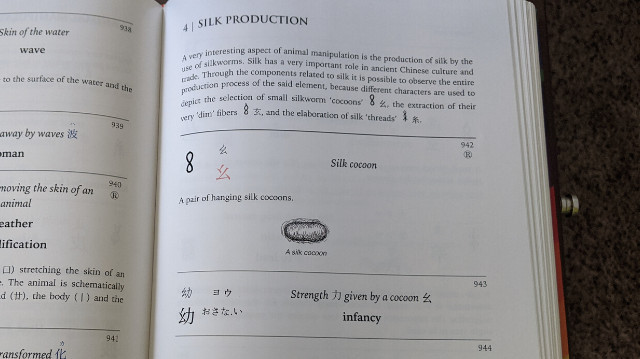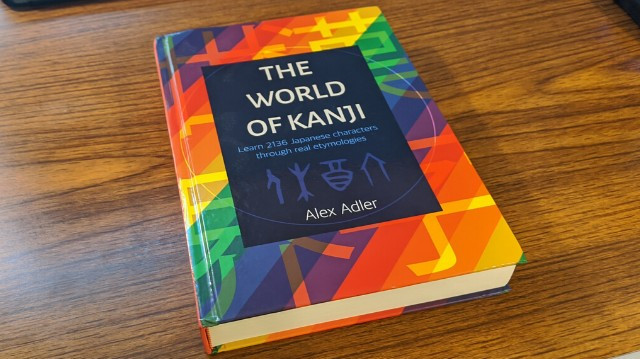Today I’m going to do a review of The World of Kanji. The full title of this book is called The World of Kanji: Learn 2136 Japanese characters through real etymologies and it’s written by Alex Adler.
I actually was a part of the Kickstarter for this book back when it first came out, so I’ve got an original copy of the hardback and a PDF copy of the material.
First let me talk about what the book aims to accomplish and then I will discuss how it does this.
Learn Kanji Through Etymology
Just like it states on the cover of the book, the goal of The World of Kanji is to teach people all 2,136 jōyō kanji (daily use Chinese characters) through the study of their etymology.
Now, the word “etymology” isn’t one that’s used all that often but the basic definition is “the study of the origin of words.”
When it comes to kanji what this means is that when the book teaches you a new kanji, it goes all the way back to when that character was first created in ancient China and what its meaning was at that time.
You get to see how it looked originally and how it has changed into its present day form. Sometimes it looks pretty much the same and sometimes it looks totally different.
I thought that this was a pretty cool concept for a couple of reasons.
One was simply because I’m interested in Japanese history, and getting to see some of the older versions of their writing system, how they changed, and why they changed was something I really loved reading about.
Another reason I liked this method was because it allows the student to use the way that they kanji looks to recall its meanings.
Granted, some kanji have been modified so much that they barely resemble their original form, but if you follow the book’s progression then you should know which ones these are and still be okay.
There are quite a few ways that people learn kanji these days:
- Repetition / Writing
- Mnemonics
- Extensive reading
- Etymology
So if learning about the history of each kanji, how it used to look, and what it means now is something that you find interesting, then this is probably a method that you would enjoy using to learn all 2,000+ kanji needed for literacy.
The Flow Of The Book

The book uses a systematic approach to teaching each character. So, it starts off pretty simple and then builds upon each entry so that by the time more complicated kanji are presented, there are only a few new aspects to them.
Furthermore, the book is divided into four “realms” that each have three sections in them.
- The Human Realm
- The Natural Realm
- The Material Realm
- The Territorial Realm
Teaching this way allows the book to group common ideas and images together, which I felt was nice since you get to see a lot of reoccurring symbols and elements in the new kanji that are presented.
Before you start jumping into the entries, it’s a good idea to read the entire introduction of the book that explains how the process is supposed to work and how Alex recommends you study each new symbol.
Although I won’t cover everything Alex says you should do to learn new kanji in this review, he does recommend reading the explanation of each entry, thinking about it’s origin and meaning, and then practice writing it out a few times.
Let me talk about a few additional aspects of the book next, and then I’ll show an example of one of the entries and talk a little about it.
Additional Aspects Of The Book
Although the book is primarily focused on teaching the “daily use kanji” though each character’s origin, there are a few other things that it covers as well.
One of them is how to write kanji.
Early on in the book it explains how to use correct stroke order, what sequence should be used when writing out each part of the character (known as the radicals), and also the notion of correct proportions.
I thought this was pretty cool since a lot of people want to be able to write Japanese as well as read it.
And even though this book is focused on teaching kanji, there are also several pages devoted to teaching people how to read and understand both hiragana and katakana.
I don’t think it’s very likely that a person who doesn’t already know the kana would get a book that teaches kanji, but I still appreciate the fact that the information is included, just in case.
Finally, there’s a lot of historical explanations included for not just individual characters, but also the entire writing system as a whole.
I think I mentioned that already, but I just feel that learning about the background of these characters will help others to connect with and feel closer to the Japanese language which then (hopefully) helps them learn it better.
Example Entries
The book has literally thousands of entries, so only showing one won’t really do it justice.
Having said that, I did want to share the main part of the book, so here is a snapshot of two new entries. Check them out below and then I’ll talk about them a little.

This is from the Animals section of the Natural Realm. It’s the fourth “chapter” of sorts within this section and it focuses on silk production.
There’s an explanation at the beginning of it that talks about silk worms, their cocoons, fibers, the importance they had in China at the time, and so on.
Then we get to see the radical that was originally used for a “silk cocoon” back when the character was first invented. This is the big “8” looking thing on the left.
Immediately to its right (in red) is how that radical looks today. You can also read the explanations of it and see a nice illustration of it at the bottom.
Then we get to the kanji 幼 that contains this element on the left side, along with another one (力) on its right. This was from an earlier section in the book, and we can see the story that was used when combining these separate components in order to form a new kanji.
There’s additional information in each section such as the kun-yomi and the on-yomi for it, a cursive version of the kanji to help you get familiar with its handwritten version, and for certain entries with multiple meanings there is additional information as well.
Because of the way that it’s setup, I feel like this is a book that you would use specifically to learn the kanji in an orderly fashion throughout the course of a year or so.
If you learned about six new kanji per day, you would complete it in a single year. This might sound a bit long, but it’s actually pretty good when you consider that Japanese kids study kanji in school for multiple years on end.
Where To Find It
Like I said earlier, I got my copies because I was a part of the Kickstarter. This book is not in print, but it does have a digital version that you can find online.
I found the method of studying the character’s origins to be a fun way to learn new kanji.
If you have any questions or comments, let me know. Thanks
Further Resources for Learning Japanese:
#3 Get My eBook (Secrets to Learning Japanese) for Free

またね!
